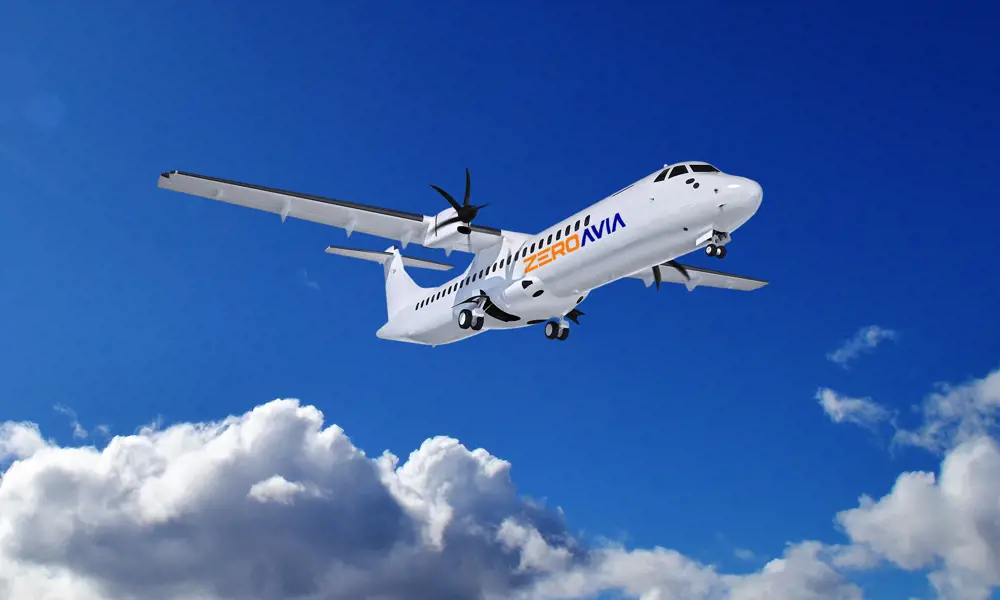
Towards zero carbon aviation
Did you know?
🛫 Commercial aviation and hydrogen fuel
- Commercial aviation accounts for 2.5% of global carbon dioxide emissions
- Hydrogen can be produced from resources including natural gas, nuclear power, biogas, and renewable power like solar and wind
- Hydrogen has more than three times the energy density of jet fuel
- 20 years from now, hydrogen could power a 200-seater aircraft over a 5,000 nautical mile flight
From 20-seat regional trips to over 100-seat long-distance flights, ZeroAvia aims to provide scalable, sustainable aviation by replacing conventional engines with hydrogen–electric powertrains.
In late 2019, the European Commission launched its Green Deal with an aim for decarbonisation: net carbon neutrality across all sectors and EU member states by 2050. This target is even more ambitious for the aviation sector, which is also working towards the Air Transport Action Group’s (ATAG) goal for carbon-neutral growth from 2020 onwards and a 50% reduction in emissions by 2050 relative to 2005 levels.
The sector has become more carbon efficient over the past three decades: more seats are being used, and operational and technology improvements have boosted fuel efficiency for the number of kilometres travelled by paying passengers by around 50%.
However, before the COVID-19 pandemic, rising demand for air travel led to a significant increase in direct CO2 emissions from aviation – 34% over the past five years. The easing of travel restrictions across the globe, growing populations and prosperity are again leading to increased demand and more measures, including alternative fuel sources, will need to be taken to accelerate the decarbonisation of aviation.
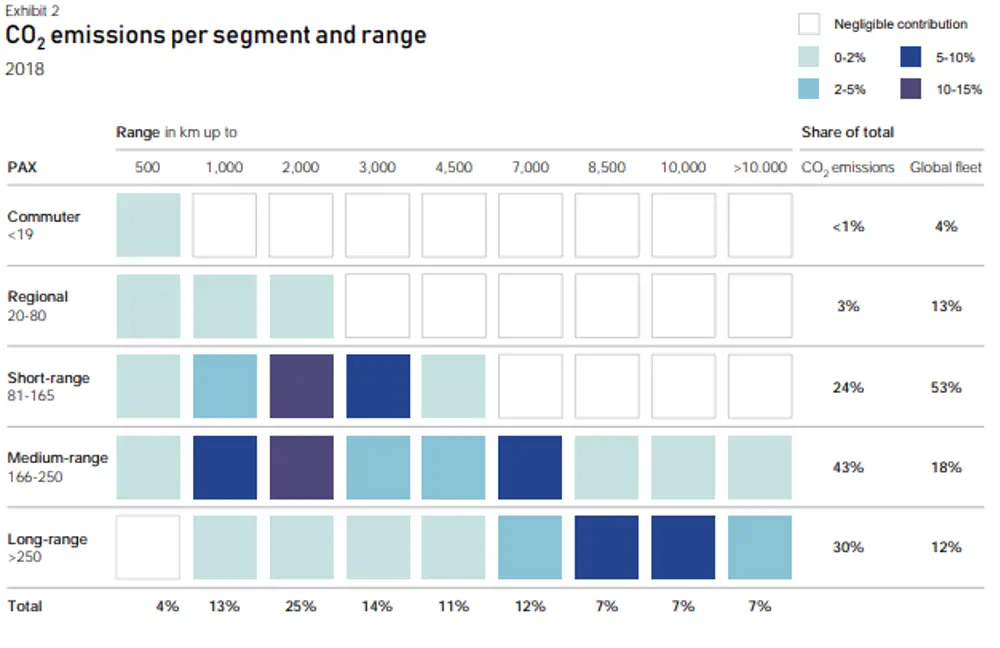
Passenger aircraft CO2 emissions per segment and range from 2018 © prepared by McKinsey & Company for the Clean Sky 2 JU and Fuel Cells and Hydrogen
The high energy needed to fuel aircrafts
A lot of energy is needed to propel a vehicle weighing hundreds of tonnes through the air at high speed. A fully laden Airbus A350, weighing 280 tonnes, requires 215.5 GJ (gigajoule) an hour to stay in the air. Therefore, aerospace is perhaps more dependent than any other sector on the exceptional energy density of hydrocarbon fuels. Over a 16- to 18-hour flight, an A350 can burn 80 to 90 tonnes of fuel, and there aren’t many energy sources that can pack as much punch into such a small mass. This dependency means that aviation is responsible for 2.5% of global carbon dioxide emissions – more than the whole of Germany. Most other sectors are turning to electrification to cut CO2 emissions, but this isn’t a viable solution for aerospace. Electric motors can power engines that generate enough thrust for flight, but the energy they need to do so has to be stored in heavy batteries, which are far heavier than full fuel tanks and, unlike fuel tanks, don’t get significantly lighter over the course of a flight.
aerospace is perhaps more dependent than any other sector on the exceptional energy density of hydrocarbon fuels

ZeroAvia’s six-seater aircraft in flight, powered by the company’s hydrogen–electric powertrain © ZeroAvia
Onboard electricity generation may be the answer, and the technology that could provide this solution has a long history. Fuel cells generate electricity by converting the energy of the reaction between hydrogen and oxygen to produce water. They were first invented in the 19th century and proved their worth in providing electricity for the capsules that took humans to the Moon in the 1960s and 70s. Hydrogen has more than three times the energy density of jet fuel, and 100 times more than the most capable commercial lithium-ion battery. It would seem to be an ideal solution, but it is fraught with difficulties, dominated by the weight of the fuel cell and the ancillary equipment needed to operate it and the large tanks needed to store high-pressure hydrogen.
Despite this, several organisations, including Boeing, Airbus and Rolls-Royce, are all developing fuel-cell-powered aircraft with Boeing first flying a converted two-seater light aircraft in 2008. The German Aerospace Centre, DLR, is also leading development. But the first commercial-sized aircraft to fly using fuel cells, a converted Piper Malibu propeller-driven six-seater, used a powertrain developed by a smaller company, ZeroAvia. The twin-engine aircraft completed an eight-minute flight at Cranfield airfield in September 2020.
The funding behind ZeroAvia
ZeroAvia was formed in 2017 in California by Val Miftakhov, a Russian physicist and serial entrepreneur who has been based in the US since 1997. In 2019, Aerospace Technology Institute (ATI), a UK government-funded organisation, began a £2.7 million project called HyFlyer, led by ZeroAvia. The funding is shared by fuel cell manufacturer Intelligent Energy and Orkney-based European Marine Energy Centre (EMEC), which has access to renewably generated hydrogen from wave and tidal energy systems mounted in the Pentland Firth. HyFlyer’s aim was to demonstrate a hydrogen fuel cell-powered passenger aircraft capable of flying 280 miles within a year.
Although the Piper flew under fuel cell power in its test flight in 2020, the fuel cell was supported by batteries, which helps to provide extra power for take-off. The batteries were operational throughout the flight, providing a safety margin, but ZeroAvia’s goal is to develop a hydrogen powertrain capable of powering the aircraft for its entire flight (although Miftakhov indicates that batteries are likely to still be incorporated for safety).
The company is developing most of the powertrain’s components itself. “So, fuel cell system, the power distribution, power electronics, motor, and overall control over that,” Miftakhov explains. “And we’re actually working on the fuel tank systems as well because today, there is no supply chain, really, for hydrogen fuel tanks for aviation. So, we work with a number of partners to create one.”
The second step on our developmental roadmap is to switch to liquefied cryogenic hydrogen, and we have much more flexibility for the shape of the tanks for liquids, so we are hoping to develop tanks for inside the wings
“The biggest challenge is what we call balance of plant,” he adds. “The fuel cell stack itself is actually relatively good from the weight perspective, we are getting good power density there. But to make it work, you also need air supply, hydrogen supply, humidification, heat exchange and other equipment, and together these are known as balance of plant. In automotive applications, fuel cell systems are significantly lighter than battery systems even with balance of plant. But we must push much harder than automotive, so reducing the weight in our balance of plant is crucial.”
The company is currently working with compressed hydrogen fuel, which cannot be carried inside the wing of the aircraft (where conventional fuel tanks are located) because of the geometry constraints needed for tanks holding compressed gases. For the prototype aircraft, seats had to be removed to make space for the tanks, and previous prototypes had carried external tanks mounted on pylons above the wings. “The second step on our developmental roadmap is to switch to liquefied cryogenic hydrogen, and we have much more flexibility for the shape of the tanks for liquids, so we are hoping to develop tanks for inside the wings,” Miftakhov says.
Challenges of energy storage and hydrogen test flights
At the time of writing, ZeroAvia’s next challenge was to complete an entire flight without a fuel cell-only powertrain before the end of 2021 with a 20-seat prototype flying from its base at Cotswold Airport in Gloucestershire.
This will use the hydrogen pressure vessels the company has developed itself, a task that proved unexpectedly difficult. “The sort of conventional compressed gas tank technology that’s used today in cars has quite low gravimetric ratios, or mass of fuel inside relative to the mass of the tank,” Miftakhov explains. “While it’s still much better energy storage than a battery, it’s not good enough for aviation. We have worked with partners to develop what some people call ‘type 5 compressed gas storage tanks’.” He claims that these allow for much better gravimetric efficiency. “We have about 11% of the mass of the filled tank as fuel, whereas type 4 tanks have a maximum of 7.58% fuel, with hydrogen at 350 bar.”
(Since this article was published in 2021, ZeroAvia has since completed its initial test flight campaign, flying a hydrogen-powered prototype 10 times over 2023)
ZeroAvia's sustainable future
ZeroAvia’s roadmap is ambitious. The company plans to be able to supply powertrains for regional turboprop aircraft, capable of carrying 50 to 90 passengers, by 2026, scaling up to 100 to 200 seaters with a 2,000 nautical mile range by 2030. Five years after that, it is targeting 200+ passenger capability across 3,000 nautical miles, and by 2040 it hopes for a range of above 5,000 nautical miles. The engines on these aircraft will have a similar engine core as turbojet engines, but instead of a propeller it spins a smaller fan with a large number of blades. Miftakhov says: “The electric motors we currently have are not capable of powering that kind of engine for longer range flight, but there is potential for motors with power densities almost an order of magnitude higher than the gas turbine engine. Motor capabilities are going to be developed and there is a relatively straightforward path to that. The fuel cell side of things for these use cases are a bit more convoluted. There are questions about the balance of plant again. How do you do air compression? How do you handle heat exchange? One thing we are looking at is higher temperature fuel cell technologies, which operate at about 200°C as opposed to the traditional sub-100°C operation. That would simplify heat management because you can exhaust heat more easily when there is a 200°C difference between your operating temperature and the ambient temperature, than when you are only 80°C different with a conventional fuel cell.”
Using carbon-free fuel is obviously a major plus for sustainability. Miftakhov notes that, elsewhere in the powertrain, the fuel cell uses platinum as a catalyst, which, although 100% recyclable, still represents a high cost element of the technology. “We don’t use any cobalt anywhere in the system, and we are pushing towards a magnet composition in the motors, which uses minimal amounts of rare earth metals, so overall our sustainability profile is pretty good.”
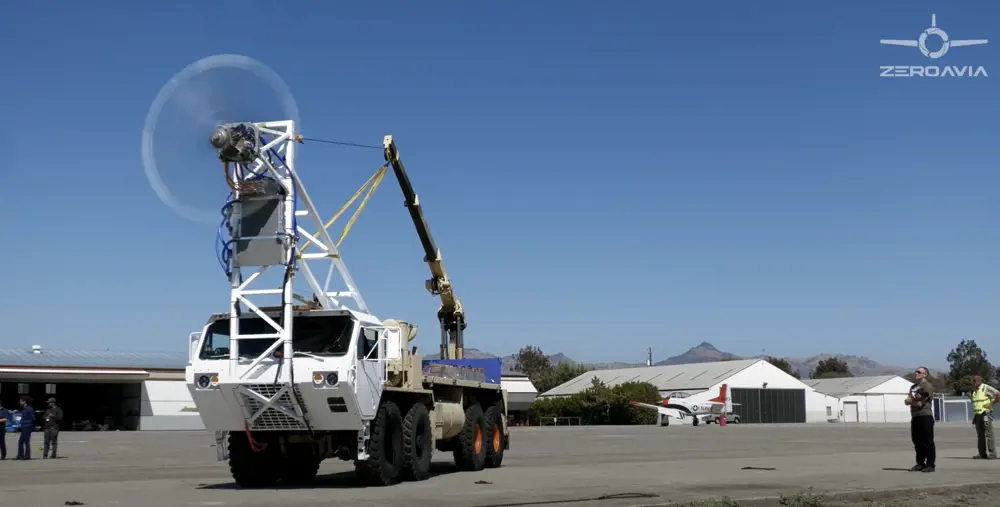
In August 2021, ZeroAvia’s hydrogen powertrain successfully pulled a 15 tonne HyperTruck mobile ground testing platform across the tarmac. The HyperTruck is based on heavy-duty military trucks and is sized for the company’s ZA-2000 2 MW+ powertrain, which can be used to test systems for 40- to 80-seat hydrogen–electric powered aircraft © ZeroAvia
The flammability of hydrogen is well known to the point of being notorious, so why is it necessary to go to the bother of using it in a fuel cell to generate electricity when it could be burned in a gas turbine in a similar way to kerosene in conventional aircraft? Miftakhov explains that this is a matter of controlling the other mechanism by which today’s aircraft contribute to global heating and climate change. While the carbon dioxide emissions of fossil fuel-powered flight are well known, they only comprise about half of the radiative forcing effect of aviation (better known as the greenhouse effect). The other half comes from the other chemical product of hydrocarbon combustion: water vapour in the form of the contrails that track aircraft movement across the skies. When aviation was paused after the 9/11 terrorist attacks in 2001, climate scientists recorded a significant drop in global temperatures because of the absence of contrails. The problem with hydrogen-fuelled gas turbines is that they exhaust water vapour at a temperature of about 1,000°C, Miftakhov says. “That’s so hot that you can’t manage it on board the aircraft. You must exhaust it into the atmosphere and that is going to create contrails in the same way that today’s aircraft do. You’d actually create about 40% more water vapour from a hydrogen gas turbine than from a hydrocarbon one. The fuel cells that we are flying now generate vapour at about 80°C, which is very easy to condense on board and exhaust as a liquid or ice pellets, which do not have a radiative forcing effect.” Moreover, he adds, any combustion in air, regardless of the fuel, risks producing toxic nitrogen oxides, and combusting hydrogen for heat is a less efficient way of liberating its energy potential than reacting it chemically with oxygen in a fuel cell. “We are talking 25% efficiency for a gas turbine compared with 50% efficiency for a fuel cell.”
We are talking 25% efficiency for a gas turbine compared with 50% efficiency for a fuel cell
The availability of a practical fuel cell-powered electric aircraft is, of course, only half the solution to improving the environmental profile of aviation. The other half is establishing the necessary infrastructure to supply zero-carbon hydrogen as a fuel. Currently, 95% of all the hydrogen produced globally is classified as ‘grey’ – that is, it is made by stripping the hydrogen away from hydrocarbons, leaving the problem of what to do with the carbon. Zero-carbon aviation can only work if the hydrogen is ‘green’; that is, produced by electrolysing water using zero-carbon electricity.
While the powerful tidal turbines and wave energy converters can supply enough green hydrogen for ZeroAvia’s current operations, they could not meet the demand of totally decarbonising aviation by 2050. Miftakhov envisages a future where a large installed capacity of zero-carbon generation provides electricity to airports, which would electrolyse water on site, providing the hydrogen that would then be used to fuel the aircraft and eliminating the risk of transporting pressurised hydrogen around road networks. This electricity supply would also have to power compression or liquefaction of the gas – an ambitious goal.
“We’d need something like 100 million tonnes a year of hydrogen to shift the entire aviation sector to zero carbon, which would need something like 600 GW of electrolysis capacity,” Miftakhov explains. “That’s about 10% of the worldwide electricity generation capacity right now so we would need a massive expansion of renewable capacity, and you have to take into account the losses in transmitting electricity from these generation sites, which are likely to be quite remote – out at sea, for example – to the airports. I am very interested in what companies such as Rolls-Royce are doing with developing small modular nuclear reactors (see ‘Nuclear designs on a low-carbon future’, Ingenia 87). That would give us the capability of housing energy generation right next to the airport. It’s an intriguing possibility for the coming decades. Meanwhile, nuclear fusion is a hard problem, but we will solve it and it will be a game changer when it happens.”
Using hydrogen safely
The use of hydrogen in transport is tainted by the Zeppelin Hindenburg, which was destroyed in a fire on landing in New Jersey in 1937, with the hydrogen filling its envelope combusting in a spectacular conflagration. The disaster killed 36 people, although 62 passengers and crew survived. Film of the fire, the cause of which is still unclear, is the main reason that any proposal to use hydrogen is still greeted with scepticism.
It is true that hydrogen can be a hazardous substance. Any concentration between 4% and 74% in air is explosive, so it must be prevented from mixing with air inside any confined space. But does that mean that hydrogen-fuelled aircraft are too dangerous to be practical?
NASA and the US Federal Aviation Administration’s safety analysis suggests that with a proper safety system around the hydrogen fuel, it can actually be safer than conventional jet fuel
Miftakhov accepts that the aerospace industry may have a job on its hands to convince the public that the use of compressed hydrogen is safe. “We definitely have some education to do. But technology has moved on in the last 84 years. NASA and the US Federal Aviation Administration’s safety analysis suggests that with a proper safety system around the hydrogen fuel, it can actually be safer than conventional jet fuel.”
A fuel leak, whether from a tank of compressed or liquefied hydrogen, will always disperse instantly with the gas rising into the air due to its low density, unlike kerosene, which pools on the ground and produces an explosive vapour-air mixture. “To ignite hydrogen, you actually need a temperature source much higher than that needed for kerosene,” Miftakhov adds. “Jet fuel is self-igniting at 200°C, so if it leaks out of an aircraft wing and drips onto the hot brakes of the landing gear, you can have an instant explosion. That could not happen with hydrogen. Even if hydrogen does ignite, the radiative heat production is far lower than that of a kerosene fire.”
Miftakhov also points out that risk perception is notoriously inaccurate. “For example, gasoline is far worse than jet fuel. But there is an art to how to persuade people, with the right level of education and well-crafted messages that are rooted in physical reality and real data.”
***
This article has been adapted from "Towards zero carbon aviation", which originally appeared in the print edition of Ingenia 89 (September 2021).
Contributors
Stuart Nathan
Author
Val Miftakhov is a serial entrepreneur in electric vehicles. He is the founder and CEO of California-based startup ZeroAvia. He has also held several senior business and product positions at Google and McKinsey & Company and was a nuclear researcher at Stanford Linear Accelerator. Val holds a PhD in physics from Princeton University, master’s in physics from Moscow Institute of Physics and Technology, and was a two-time winner of nationwide Russian physics competitions. In his spare time, Val makes good use of his airplane and helicopter pilot licences.
Keep up-to-date with Ingenia for free
SubscribeRelated content
Environment & sustainability
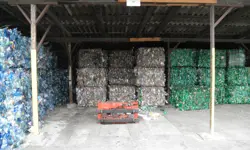
Recycling household waste
The percentage of waste recycled in the UK has risen rapidly over the past 20 years, thanks to breakthroughs in the way waste is processed. Find out about what happens to household waste and recent technological developments in the UK.

Upgrade existing buildings to reduce emissions
Much of the UK’s existing buildings predate modern energy standards. Patrick Bellew of Atelier Ten, a company that pioneered environmental innovations, suggests that a National Infrastructure Project is needed to tackle waste and inefficiency.

An appetite for oil
The Gobbler boat’s compact and lightweight dimensions coupled with complex oil-skimming technology provide a safer and more effective way of containing and cleaning up oil spills, both in harbour and at sea.
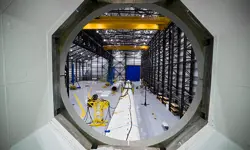
Future-proofing the next generation of wind turbine blades
Before deploying new equipment in an offshore environment, testing is vital and can reduce the time and cost of manufacturing longer blades. Replicating the harsh conditions within the confines of a test hall requires access to specialist, purpose-built facilities.
Other content from Ingenia
Quick read

- Environment & sustainability
- Opinion
A young engineer’s perspective on the good, the bad and the ugly of COP27

- Environment & sustainability
- Issue 95
How do we pay for net zero technologies?
Quick read

- Transport
- Mechanical
- How I got here
Electrifying trains and STEMAZING outreach

- Civil & structural
- Environment & sustainability
- Issue 95